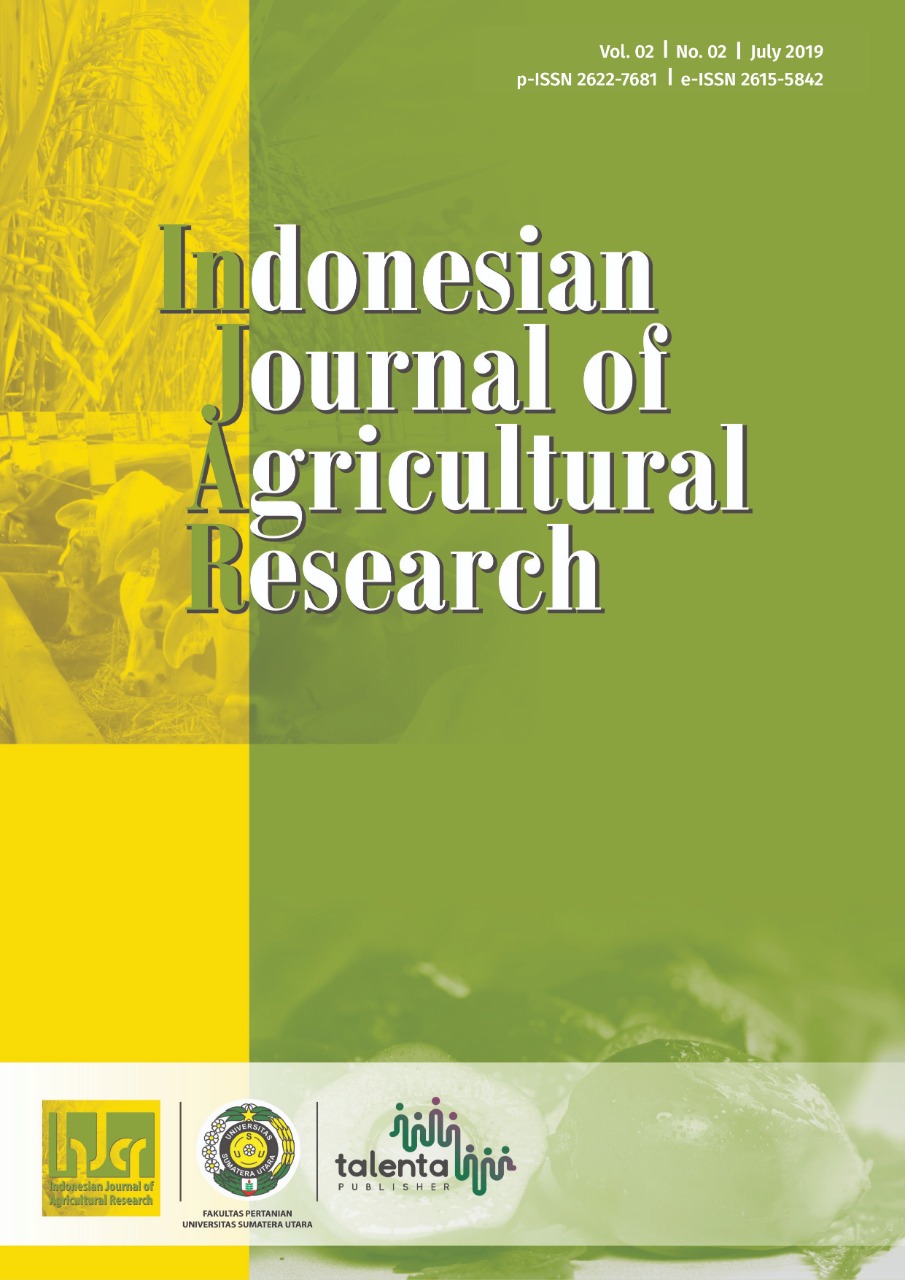Palatability Test of Mineral Herbal Blocks on Performans of Local Sheep
DOI:
https://doi.org/10.32734/injar.v2i2.924Keywords:
herbal, minerals, palatability, sheepsAbstract
This research was aimed to study of palatability and body weight gain local sheeps given minerals herbal (MBH). The farms used in this study were male 4 local sheep at the age of 12-18 months who showed symptoms of mineral deficiency. The research method used is the Latin Square Design (LSD). The treatment given is: H0 = Basal Feed + Salt; H1 = Basal Feed + Salt + Mineral + Turmeric; H2 = Basal Feed + Salt + Mineral + Ginger; H3 = Basal Feed + Salt + Mineral + Turmeric + Ginger. The research parameter is the mineral palatability of herbal blocks and body weight gain. The results showed that MBH given turmeric (10%), ginger (10%) and a combination of 5% + 5% ginger showed a non-significant effect on feed consumption and conversion. Palatability test showed that all MBH treatments were favored by local sheep, but the highest palatability of MBH was by adding ginger; followed by a combination of ginger and turmeric; and the lowest palatability is turmeric. Based on palatability tests, MBH with turmeric supplementation of 10%; 10% ginger or a combination of 5% ginger + 5% turmeric in the form of Herbal Minerals Block has a good palatability (preferred) and can improve the performance of local sheep.
Downloads
References
J. W. Purseglove, E. G. Brown, C. L. Green and S.R.J. Robins. Species. vol. 2. Longman, London and New York, 1981.
M. W. Sidik, Moelyono and A. Muhtadi. “Temulawak (Curcuma xanthoriza, Roxb.) Pengembangan dan Pemanfaatan Obat Bahan Alam†Phytomedica, 1995.
T. Sutardi, Landasan Ilmu Nutrisi. Diktat Kuliah.Fakultas Peternakan. Bogor: Institut Pertanian Bogor, 1980.
B. Haryanto. “Pakan domba dan kambing,†Proseding Sarasehan Usaha Ternak Domba dan Kambing Menyongsong Era PJPT II. Balai Penelitian Ternak, Ciawi. 1992.
National Research Council. Nutrient Requirement of Sheep. National. Academy Press, Washington. 2006.
Arifin and Kardiyono. “Temulawak dalam pengobatan Tradisionalâ€. Proseding Simposium Nasional Temulawak. Lembaga penelitian Universitas Pajajaran. Bandung. pp. 210-219, 1985.
Arora, Pencernaan Mikrobia pada Ruminansia. Gadjah Mada. Yogyakarta: University Press, 1989.
A. Sudarman and D. A. Astuti, Pemberian sabun-Ca dari minyak lemuru dengan penambahan aroma herbal untuk produksi daging domba dan susu kambing rendah kolestero. Laporan Penelitian. Bogor: Institut Pertanian Bogor, 2007.
E. Tillman, H. Hartadi, S. Reksohadiprojdo and S. Lebdosoeharjo. Ilmu Makanan Ternak Dasar. Yogyakarta: Gadjah Mada University Press, 1998.
W. G. Pilliang and S. Djojosoebagio, Fisiologi Nutrisi. vol. 1 dan 2. Bogor: Institut Pertanian Bogor Press, 2006.
T. N. Edey. Tropical Sheep and Goat Production. Australia University International. Canberra. 1983.
W. G. Pond, D. C. Church and K. R. Pond. Basic Animal Nutrition and Feeding. 4Th Ed, John Wiley and Sons Press, New York, 1995.
M. C. Nesheim, R. E. Austic and L. E. Card. Poultry Production. Lea and Febiger, Philadelphia. 1979.
R. Anggorodi, Ilmu Makanan Ternak Umum. Jakarta: PT Gramedia, 1994.
W. Pujiastuti. “Pengaruh Pemberian Temulawak (Curcuma Xanthorriza, Roxb) dan Minyak Kelapa Dalam Ransum Terhadap Kadar Lemak Dan Kolesterol Telur,†Seminar Nasional Teknologi Peternakan dan Veteriner. Balai Penelitian Ternak, Bogor, 2001
Downloads
Published
How to Cite
Issue
Section
License
Copyright (c) 2019 Indonesian Journal of Agricultural Research

This work is licensed under a Creative Commons Attribution-ShareAlike 4.0 International License.



















